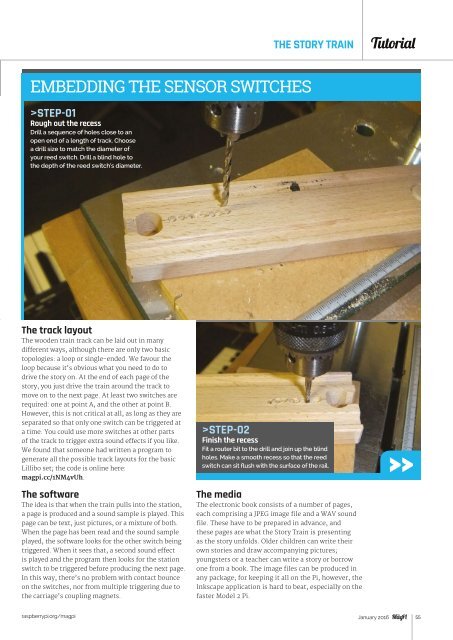You also want an ePaper? Increase the reach of your titles
YUMPU automatically turns print PDFs into web optimized ePapers that Google loves.
THE STORY TRAIN<br />
Tutorial<br />
EMBEDDING THE SENSOR SWITCHES<br />
>STEP-01<br />
Rough out the recess<br />
Drill a sequence of holes close to an<br />
open end of a length of track. Choose<br />
a drill size to match the diameter of<br />
your reed switch. Drill a blind hole to<br />
the depth of the reed switch’s diameter.<br />
The track layout<br />
The wooden train track can be laid out in many<br />
different ways, although there are only two basic<br />
topologies: a loop or single-ended. We favour the<br />
loop because it’s obvious what you need to do to<br />
drive the story on. At the end of each page of the<br />
story, you just drive the train around the track to<br />
move on to the next page. At least two switches are<br />
required: one at point A, and the other at point B.<br />
However, this is not critical at all, as long as they are<br />
separated so that only one switch can be triggered at<br />
a time. You could use more switches at other parts<br />
of the track to trigger extra sound effects if you like.<br />
We found that someone had written a program to<br />
generate all the possible track layouts for the basic<br />
Lillibo set; the code is online here:<br />
magpi.cc/1NM4vUh.<br />
The software<br />
The idea is that when the train pulls into the station,<br />
a page is produced and a sound sample is played. This<br />
page can be text, just pictures, or a mixture of both.<br />
When the page has been read and the sound sample<br />
played, the software looks for the other switch being<br />
triggered. When it sees that, a second sound effect<br />
is played and the program then looks for the station<br />
switch to be triggered before producing the next page.<br />
In this way, there’s no problem with contact bounce<br />
on the switches, nor from multiple triggering due to<br />
the carriage’s coupling magnets.<br />
>STEP-02<br />
Finish the recess<br />
Fit a router bit to the drill and join up the blind<br />
holes. Make a smooth recess so that the reed<br />
switch can sit flush with the surface of the rail.<br />
The media<br />
The electronic book consists of a number of pages,<br />
each comprising a JPEG image file and a WAV sound<br />
file. These have to be prepared in advance, and<br />
these pages are what the Story Train is presenting<br />
as the story unfolds. Older children can write their<br />
own stories and draw accompanying pictures;<br />
youngsters or a teacher can write a story or borrow<br />
one from a book. The image files can be produced in<br />
any package; for keeping it all on the Pi, however, the<br />
Inkscape application is hard to beat, especially on the<br />
faster Model 2 Pi.<br />
raspberrypi.org/magpi January 2016 55


